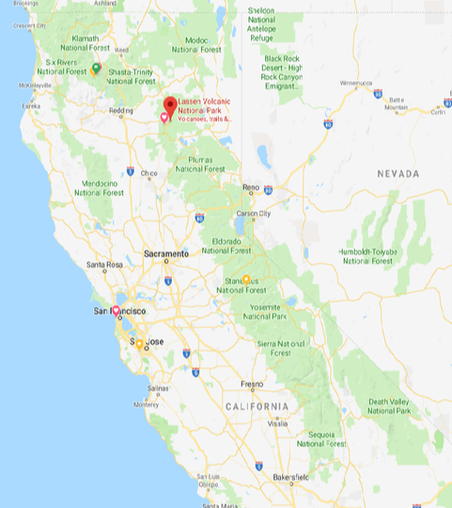RAINBOW - HORSESHOE LAKE LOOP & CINDER CONE
I was very pleasantly surprised by the beauty and geologic significance of Lassen National Park on my first visit there in August 2019. I was seeking a low-key trip with a chance to see key features of the park. I also had the chance to test my new backpacking tent from Tarptent, the Notch, which was much more lightweight than my older tent.
I highly recommend the 30-minute video in the Kohm Yah-mah-nee Visitor Center that illustrates the immense power and devastation from the last eruption in 1915-1922. Knowing such an eruption could repeat at any time gave me pause...
After the visitor center I stopped at the Sulphur works, a fascinating boiling sulfur mudpot, viewable from a safe distance.
I also stopped at the Bumpass Hell overlook on the way to the Summit Lake campground.
After camping overnight at the Summit Lake South campground, I set off the next morning for my loop hike into the park, starting from the Summit Lake Trailhead. The weather was perfect, sunny but not too warm. I hiked past Echo Lake, some lakelets, and then Upper and Lower Twin Lakes. The first destination was Rainbow Lake, an easy 5.7 mi / 9 km east. On a Monday night, I had the entire lake to myself, except for several very active deer.
The next morning I started a day hike to Cinder Cone, an iconic feature of the park. The exposed trail and warm weather made a splash in Rainbow Lake mandatory at the end of the hike. Slideshow of the hike (~8.5 mi / 13.7 km) , and views from Cinder Cone, below.
View from the Top of Cinder Cone
The next day I packed up and headed for the eastern part of the loop, skirting Snag Lake, hiking south past Grassy Creek, and camping at Horseshoe Lake. The mosquitoes were few and there were footbridges over all the crossings of Grassy Creek. This was a delightful trail! I had Horseshoe Lake all to myself too, except for quite a few deer who were not at all shy.
The next day's plans included a morning hike east to Juniper Lake, passing by the Forest Service Cabin, and back to camp, before packing up and heading north to close the loop, camping at Lower Twin Lake. The weather was perfect and Juniper Lake was quiet, with few visitors. After about 9 miles / 14 km, I arrived at Lower Twin Lake to set up camp, after passing by Crater Butte and Swan Lake.
Morning mist on Horseshoe Lake
Juniper Lake
The next day's hike was only 4.9 mi / 7.9 km back to the Summit Lake Trailhead, then a drive to Manzanita Lake Campground for a hot shower!
This turned out to be an excellent backpacking trip, with fascinating and unique geography, scenic lakes and trails, and plenty of solitude. Plus, I was quite happy with the Tarptent Notch: it offered plenty of space, easy to assemble and disassemble and definitely lightweight. It does require significant staking weight (rocks) for stability, and leaving camp for a day hike means you have to leave the tent collapsed and weighted down if you need your trekking poles, or give up the trekking poles to keep the tent up. I tried both, and it was a small price to pay for the weight savings.
Photographs by Cris Lewis, Olympus TG-2





































